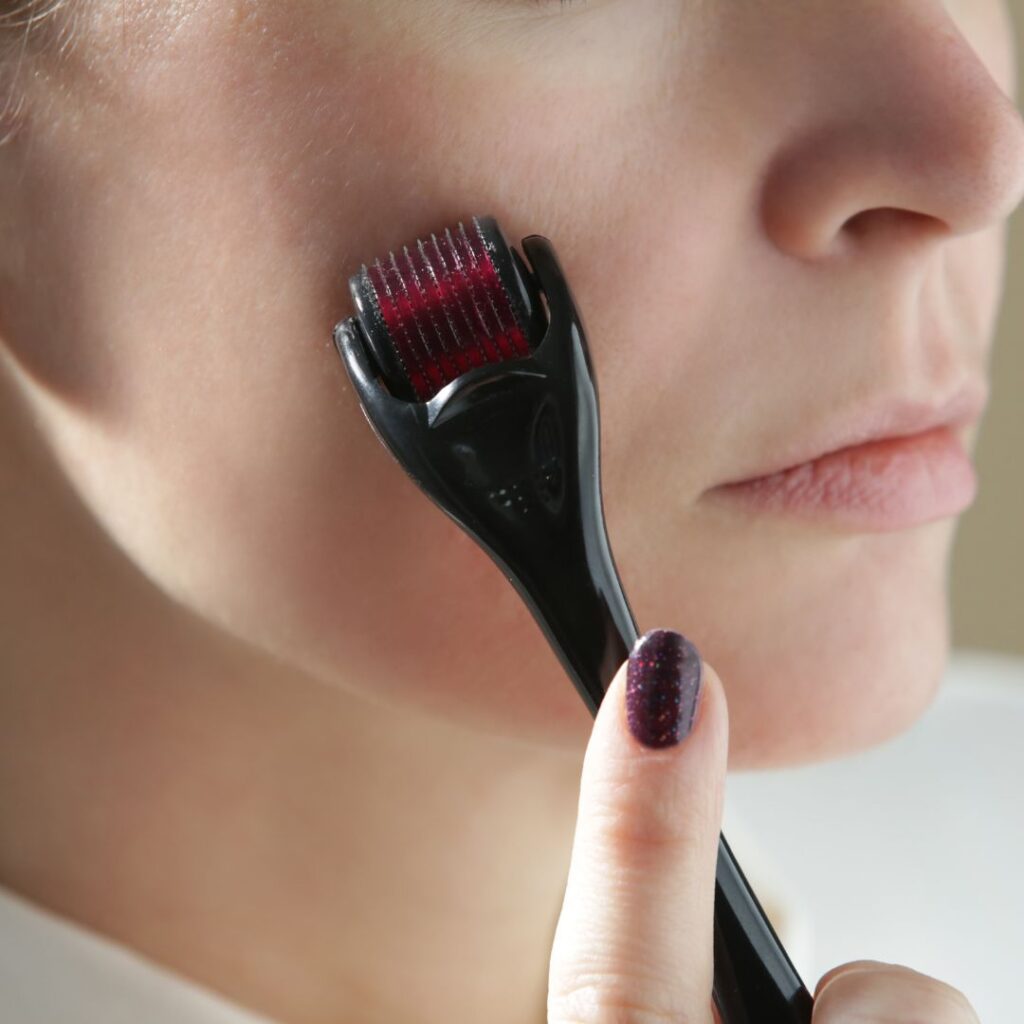You’re eager to incorporate microneedling into your at-home skincare routine, but you’re unsure of how frequently it should be done. In this article, we’ll unravel the mystery of how often to microneedle at home and provide you with some valuable insights. Whether you’re a novice or a seasoned pro, we’ve got you covered with expert recommendations to ensure you achieve optimum results without compromising the health of your skin. So, let’s dive in and discover the perfect microneedling frequency for you!
Understanding Microneedling
Microneedling is a popular skincare procedure that involves using a device with tiny needles to create micro punctures in the skin. These controlled injuries stimulate collagen production and promote skin rejuvenation. It is a non-invasive treatment that can be done at home or by a professional.
What is Microneedling?
Microneedling, also known as collagen induction therapy, is a cosmetic procedure that aims to improve the appearance of the skin. This technique involves making tiny punctures in the skin using a microneedling device. The needles create micro channels that trigger the body’s natural healing process, resulting in increased collagen and elastin production.
How Does Microneedling Work?
Microneedling works by breaking down the skin’s surface and stimulating the production of new collagen and elastin fibers. The tiny punctures created by the microneedling device activate the body’s natural healing process, which leads to rejuvenated and improved skin texture and appearance. Additionally, these microchannels allow for better absorption of skincare products.
Benefits of Microneedling
Microneedling offers numerous benefits for the skin. First and foremost, it stimulates collagen production, which helps improve the skin’s elasticity and firmness. This can lead to a reduction in the appearance of fine lines, wrinkles, and acne scars. Microneedling also enhances the absorption of skincare products, making them more effective. Additionally, it can improve the overall texture and tone of the skin, resulting in a more youthful and radiant complexion.
Microneedling Frequency
Determining the frequency of microneedling treatments is crucial to achieve optimal results without causing harm to your skin. Several factors should be considered when deciding how often to perform microneedling at home.
Skin Type and Condition
Your skin type and condition play a significant role in determining the frequency of microneedling. If you have sensitive or easily irritated skin, it is advisable to space out your treatments to avoid excessive irritation. On the other hand, if you have resilient skin, you may be able to tolerate more frequent treatments.
Professional Guidance
It is always recommended to seek professional guidance before embarking on a microneedling routine, especially if you are a beginner. A skincare professional can assess your skin’s needs and provide personalized recommendations on the frequency that would be best suited for you. They can also guide you on the appropriate needle length and technique to ensure optimal results.
General Recommendations
As a general guideline, it is advisable to start slowly and gradually increase the frequency of your microneedling sessions. This allows your skin to adapt to the treatment and minimizes the risk of adverse reactions. Monitoring your skin’s reactivity after each session is essential in determining the optimal frequency for your specific skin type and condition.

Determining Your Microneedling Schedule
Establishing a microneedling schedule that works for you requires a careful approach. By starting slowly and building up frequency, you can find the balance that yields the best results for your skin.
Starting Slowly
If you are new to microneedling, it is best to start with less frequent treatments. Begin with a once-every-four-weeks schedule to allow your skin to adjust to the procedure. This will also give you time to assess how your skin reacts and heals after each session.
Building up Frequency
After a few initial sessions, you can gradually increase the frequency of your microneedling treatments. Some individuals find that having a session every two to three weeks is sufficient to achieve their desired results. However, it is essential to listen to your skin and adjust the frequency accordingly.
Monitoring Skin Reactivity
During the course of your microneedling journey, closely monitor how your skin reacts to the treatments. If you notice excessive redness, inflammation, or prolonged downtime, it may be a sign that you need to reduce the frequency of your sessions. Adjusting the schedule based on your skin’s response will help maintain its health and prevent overuse.
Microneedling Schedule Recommendations
Depending on individual needs and goals, different microneedling schedules can be recommended for optimal results.
Once Every 4 Weeks
For those with sensitive or easily irritated skin, starting slow and opting for a once-every-four-weeks schedule is a safe choice. This frequency allows for ample time for your skin to recover and limits the risk of irritation or adverse reactions.
Once Every 2-3 Weeks
If your skin is more resilient and can tolerate regular treatments, scheduling microneedling once every two to three weeks may be suitable. This frequency provides closer maintenance for the beneficial effects of the treatment and can lead to noticeable improvements in the skin’s texture and appearance.
Once a Week or More
Intensive microneedling schedules, such as once a week or more, are typically reserved for individuals with specific skin concerns or under the guidance of a skincare professional. This frequency should only be adopted after careful consideration and assessment of your skin’s reaction to the treatment.
Factors to Consider
When determining your microneedling schedule, it is essential to take into account various factors that can influence the frequency and intensity of the treatments.
Skin Sensitivity
Individuals with sensitive skin should proceed with caution when it comes to microneedling. Higher frequencies or longer needle lengths can potentially cause irritation, redness, or even damage the skin’s barrier. It is crucial to prioritize the health and comfort of your skin over achieving quick results.
Skin Condition
The condition of your skin also plays a role in determining how often you should undergo microneedling. For individuals with severe acne, active skin infections, or open wounds, it is advisable to avoid microneedling until the condition improves. Microneedling can exacerbate these issues and hinder the healing process.
Targeted Concerns
The specific concerns you are targeting with microneedling can influence the frequency of your treatments. For example, if you are primarily focusing on reducing the appearance of fine lines and wrinkles, a more intensive schedule may be required. However, if you are using microneedling to improve overall skin texture and tone, a less frequent schedule might suffice.
Avoiding Overuse and Side Effects
While microneedling can deliver remarkable results, it is crucial to avoid overuse and potential side effects. This can be achieved by following guidelines and seeking professional advice.
Potential Side Effects
Microneedling, when done correctly, is generally safe. However, there are potential side effects that can occur if the procedure is performed too frequently or with improper technique. These side effects can include redness, swelling, bruising, and infection. It is crucial to always follow proper hygiene practices and use a clean and sterilized microneedling device.
Importance of Following Guidelines
Following guidelines for microneedling is essential to prevent complications and maximize results. This includes using the appropriate needle length for your specific skin concerns, avoiding aggressive treatments, and properly cleaning and caring for your skin before and after each session. Adhering to these guidelines will minimize the risk of adverse reactions and ensure safe and effective treatments.
Consulting a Professional
If you are unsure about how often to perform microneedling at home or if you have any concerns about potential side effects, it is advisable to consult a skincare professional. They can assess your skin’s needs, provide personalized recommendations, and guide you through the microneedling process. Professional supervision and expertise can greatly enhance your microneedling experience and help you achieve the best possible results.

Aftercare and Recovery
Proper aftercare and post-treatment skincare are crucial to ensure optimal healing and maximize the benefits of microneedling.
Post-Treatment Skincare
After a microneedling session, your skin needs time to recover and heal. It is essential to follow a gentle and nourishing skincare routine to aid in the healing process. This may include using a mild cleanser, a hydrating serum, and a moisturizer to keep the skin hydrated and protected. Additionally, avoid using harsh or irritating products, including exfoliants or retinol, immediately after microneedling.
Avoiding Sun Exposure
Following microneedling, it is crucial to protect your skin from excessive sun exposure. The treated skin becomes more vulnerable to UV damage, which can hinder the healing process and potentially cause pigmentation issues. Apply a broad-spectrum sunscreen with a high SPF and wear protective clothing or a wide-brimmed hat when going outdoors.
Monitoring Healing Process
As your skin heals after microneedling, closely monitor its progress and any potential side effects. Keep an eye out for signs of infection, prolonged redness, or any other lingering skin issues. If you are concerned about the healing process, reach out to a skincare professional for guidance and reassurance.
Alternate Microneedling Methods
In addition to traditional microneedling, there are alternative methods that can be used to achieve similar results.
Derma-rolling
Derma-rolling, or using a derma roller, is a variation of microneedling that involves a rolling device with multiple needles. This method works similarly to microneedling but covers a larger area in a shorter amount of time. The frequency of derma-rolling sessions can follow the same guidelines as microneedling, taking into consideration your skin type and condition.
Stamping Devices
Microneedling stamping devices feature a smaller head with a concentrated cluster of needles. This allows for more precise targeting of specific areas on the skin. Stamping devices are particularly beneficial for concerns such as acne scars, deep wrinkles, or stretch marks. The frequency of treatments will depend on the specific skin concerns and should be discussed with a skincare professional.
Microneedling Pens
Microneedling pens, also known as electronic or automated devices, are handheld devices that rapidly and vertically move the microneedles into the skin. This results in more controlled and consistent punctures compared to manual methods. The frequency of microneedling pen treatments can generally follow the same guidelines as traditional microneedling.
How to Maximize Results
To maximize the results of microneedling, it is beneficial to incorporate certain practices and considerations into your skincare routine.
Using Serums or Topical Products
After microneedling, your skin is primed to absorb topical products more effectively. Take advantage of this by applying serums or other targeted skincare products immediately after your treatment. Ingredients like hyaluronic acid, vitamin C, or peptides can provide additional benefits to support collagen production and skin rejuvenation.
Personalized Skincare Routine
Microneedling is most effective when combined with a personalized skincare routine tailored to your skin’s specific needs. This may include using products that target your concerns, such as acne, hyperpigmentation, or dryness. Additionally, maintaining a consistent and comprehensive skincare routine will help support the results of microneedling treatments.
Combining with Other Treatments
Microneedling can be combined with other aesthetic treatments to enhance the overall results. For example, pairing microneedling with radiofrequency or LED therapy can further boost collagen production and tighten the skin. However, it is crucial to consult with a skincare professional to ensure compatibility and safety when combining treatments.

